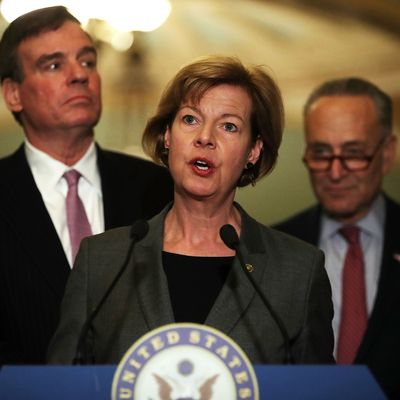
In July, last time Morning Consult published a state-by-state compilation of approval/disapproval rating data for U.S. senators, three members of the upper chamber, all Republicans, were “underwater”: the two senators from Arizona, Jeff Flake and John McCain, and Senate Majority Leader Mitch McConnell. In its latest surveys, McCain has improved his ratings (presumably thanks to Democratic-independent appreciation for his rebellion against his party on health care), the now-retiring Flake is in even worse shape, and McConnell, who has been taking a pounding from both Donald Trump and Steve Bannon, is way underwater at 33/55. Bernie Sanders remains the most popular senator in the country with his constituents, with a 71/22 approval rating.
But generally speaking, senatorial popularity has been trending downward slowly all year, more or less in synch with the president’s gradually deteriorating numbers. Still, with a few exceptions, the senators facing voters in 2018 are in reasonably good shape. With 26 Democratic seats up next year as opposed to just 8 Republican seats, it remains unlikely Democrats will retake control of the Senate next year — or that Republicans will make major gains.
Right now the senator up in 2018 (putting Flake aside) with the worst approval ratio is Republican Dean Heller of Nevada (39/39), a state Trump lost last year; Trump’s own approval ratio there earlier this month (according to Morning Consult as well) was 44/51.
Of the “Trump Ten” Democrats running in states the president carried last year, none are “underwater.” Looking at Trump’s approval ratios and their own, the one Democrat from a state where Trump is really popular, at 60/36, is Joe Manchin, whose own ratio is a healthy 53/36.
Four Democrats are from states where Trump’s approval rating is right at 50 percent; among them Claire McCaskill of Missouri is the most vulnerable at 42/39; followed by Joe Donnelly of Indiana at 47/26; and then the quite-popular Heidi Heitkamp of North Dakota at 55/32 and Jon Tester of Montana at 53/33.
Bill Nelson of Florida is a relatively strong 50/26, while Trump’s a bit meh in the Sunshine State at 48/47. Tammy Baldwin of Wisconsin is looking vulnerable at 41/38, but then Trump’s quite unpopular in her state at present, at 41/53.
Trump’s underwater ratings in Ohio (46/49) and Pennsylvania (45/50) provide some comfort for relatively popular Democratic senators Sherrod Brown (47/28) and Bob Casey (43/32), respectively. And Debbie Stabenow’s a lot more popular in Michigan (45/36) than is the president (40/55).
How all the 2018 Senate races evolve will depend a lot, of course, on who runs against the incumbents — or indeed, whether some of them join Flake and Bob Corker in retirement. For example, the relatively popular Bill Nelson will probably have to face the financial Death Star Rick Scott, while there are potentially nasty GOP primaries in Arizona, Indiana, and Nevada. And Breitbart News’ Steve Bannon is threatening to back primary challenges to several Republican senators who have not been on anyone’s radar screen, including Deb Fischer of Nebraska (45/35), John Barrasso of Wyoming (53/26), and Roger Wicker of Mississippi (49/26). There’s even a competitive Democratic primary on tap in California, where state senate majority leader Kevin DeLeon is challenging Diane Feinstein (47/33), though the state’s top-two primary system might mean these candidates stage a rematch in the general election.
If 2017’s slow slide of senatorial approval ratings continues into 2018, the landscape could well become more competitive, though again, Republican odds of knocking off Democratic incumbents might be undermined by the president’s low ratings. It will be an expensive scramble still more likely than not to produce a partisan standoff.






























